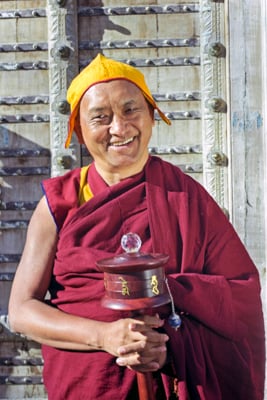Ven. Roger: What is most critical to Rinpoche is making the holy objects meaningful for others so they get the full benefit of their real reason for existing according to the Buddha’s teachings. From your explanation in a previous email, after Rinpoche went to some lengths to explain the importance of having the holy objects filled correctly with the proper mantras and substances, you seemed to indicate you would merely put back the damaged or incomplete things that were already in the prayer wheels and holy objects. Rinpoche mentioned the importance of Buddhism and its purity, and dictated the advice below, which emphasizes the importance of correctly filling holy objects.
Rinpoche: Buddha said we should not put an incomplete text inside a holy object. Hinduism has deep meditation, more than Christianity. We can achieve up to the formless realm, the tip of samsara, through meditation and by following the inner pleasure derived from meditation. Eventually by wanting more and more pleasure we reach the formless realm, the limitless sky, then limitless consciousness, then nothingness and then the tip of samsara.
This is the way Hinduism develops to the peak experience, the tip of samsara, but at that point we never get aversion to that, so we stay in samsara. This is the fourth level of the formless realm, to which attraction simply doesn’t get stopped. When the karma for that experience finishes, we are reborn in the lower realms, as a human or in an even lower realm.
We have been through this process numberless times, even achieving one-pointed concentration. The conclusion is that the Hindu religion doesn’t have renunciation, bodhicitta and emptiness, the three principal aspects of the path, which are the proper and correct basis for practicing tantra. Without these our practice of tantra is not correct and we are like a bird with only one wing.
With these three, we can practice tantra correctly, which is exalted, pure appearance and pure thought. In tantra this is the basis, purifying ordinary view and conception and developing pure primordial wind and mind that continues to enlightenment.
So we cannot fill up the stupa, prayer wheel or statue with texts that have missing pages. This is the same for all four sects of Tibetan Buddhism; this is the basic knowledge.
We need to be careful of the idea that is similar to the Western way of thinking and is not Buddhist. For Westerners, human kaka a thousand years old becomes very precious and can even go in a museum. That is a Western idea not a Buddhist idea.
There is a story in Kham about an American who sponsored paintings. He wanted to take the very old paintings and carefully restore them, but the monks in the monastery simply wanted to have new paintings done, which would create incredible merit. According to the Western style old things are very important, but that’s not thinking about the merit and purification of creating a new holy object. So the monks wanted new paintings. Of course, if the painting is done by an artist who is a great holy being then it would be different.
My point is that putting old, worn out mantras or texts with missing pages inside the holy objects is not right. Old texts that cannot be used can go in a small square house or in a cave. This is what we do in Rolwaling.
I just wanted you to understand that it’s best not to put incomplete texts or old texts that are deteriorated in holy objects. This is very important, and this is respecting the objects of our refuge practice.
It is very important to follow the Three Rare Sublime Ones, who guide us to liberation and help us to be free from the oceans of samsaric sufferings. They bring us to enlightenment, so we need to show respect. So it is important to still respect those texts that are old or have missing pages and put them in a higher place. The ancient Kadampa geshes in Tibet would pick up any small part of texts etc., and place it on their head immediately out of respect. Also you cannot step over a text or use it as a seat.
My teacher, Kirti Tsenshab Rinpoche, for example, was very careful to always have great respect for even small parts of the robes of a monk and nun, remembering their qualities and how many precepts they keep. He then put those objects in a higher place out of respect. This is how the Sangha and lay people in Rolwaling practice. It is great. Regarding the texts that go in the holy objects, it is very important to get clear texts or mantras, etc. You can get these in Delhi or Kathmandu.
Also, for those large prayer wheels that are not just relying on paper texts, you can use microfiche and in this way you can fit billions of mantras inside the holy objects. This becomes an excellent way to create merit and achieve full enlightenment.
Here in the US we have a number of large prayer wheels and in fact in many of our centers around the world we also put microfiche inside the prayer wheels, so then many more mantras and prayers can fit into the prayer wheels or holy objects. One large prayer wheel we have in California has more than 65 billion mantras on microfiche.
The purpose of all this is to be free quickly from the oceans of samsaric sufferings, by doing it in the correct way.





























